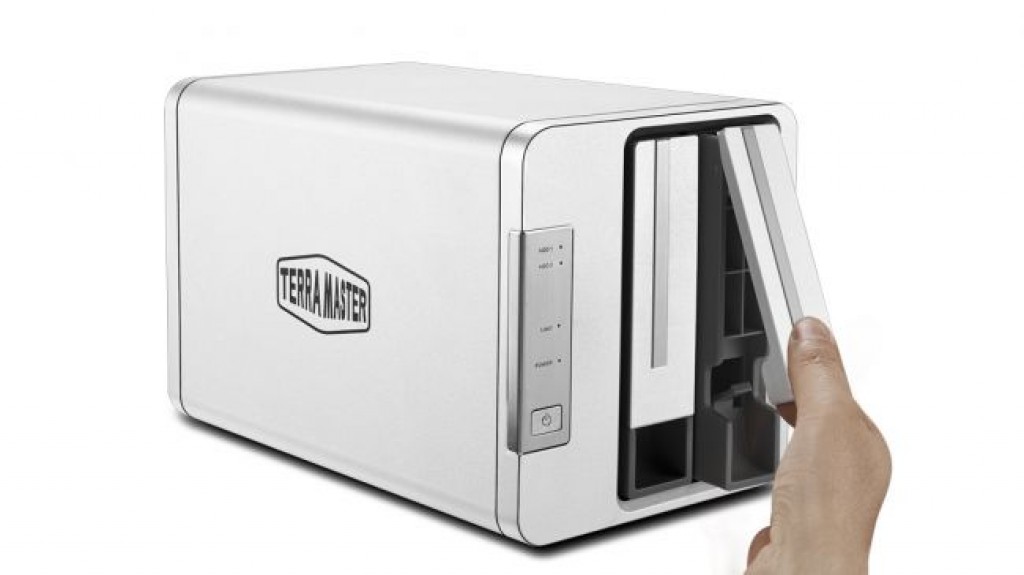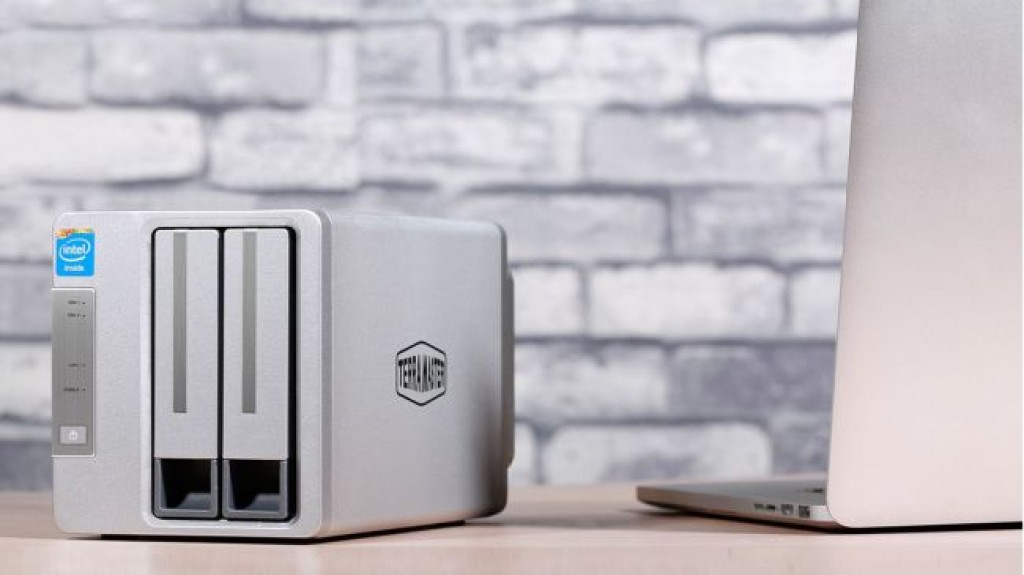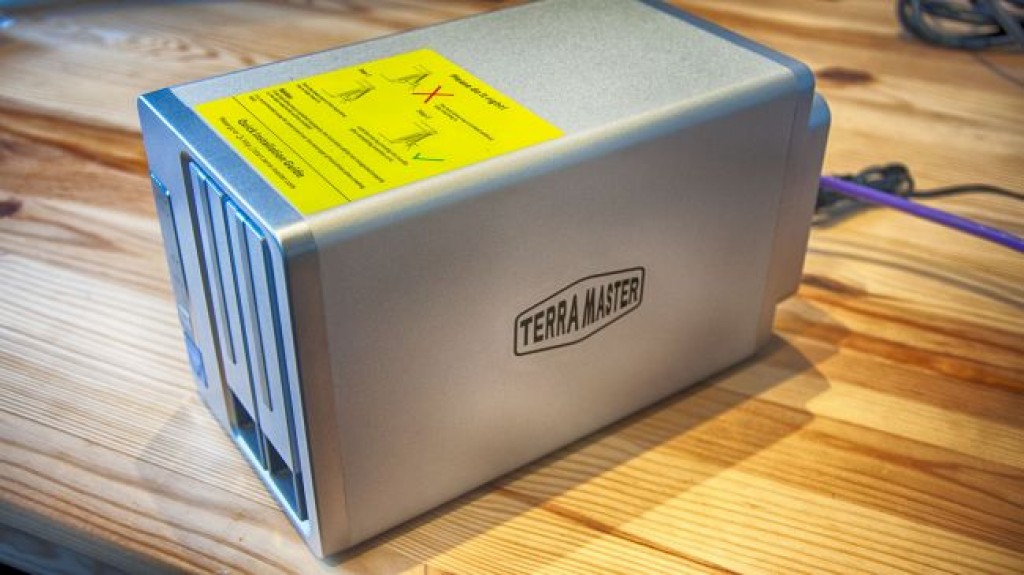
OUR VERDICT
- The F2-220 is a robustly constructed and powerful NAS offering that can fully saturate the available bandwidth of Gigabit Ethernet, but it lacks the software maturity of rival devices.
FOR
- Impressive build quality
- Powerful performance
- Easy enough to set up
AGAINST
- No drive locks
- Limited app selection
- Missing power management
TerraMaster is a brand of Noontec, a company that primarily sells headphones. However, in the electronics game diversification is key, and with TerraMaster the company has plunged into the personal and small business NAS market with both feet.
The F2-220 is one of twelve NAS products the firm makes ranging from single drive devices to the four-drive units meant for small business users.
The dual-drive NAS boxes like this one are either for people who need more capacity than a single disk can hold, or are sufficiently paranoid about data loss to realize the value of resilient multi-drive solutions.
Being a remarkably competitive market, can TerraMaster crash this party with the F2-220, a NAS box which retails at around £180 (or $190 in the US)?

Design
TerraMaster went with the front loading option on the F2-220, meaning that the anterior view is dominated by the drive bays, neither of which can be locked.
With the exception of a power button and a few subtle LED indicator lights, this is a very clean design. Had TerraMaster resisted the urge to slap an ‘Intel Inside’ sticker on it, this unit might have been even better looking.
The maker also stuck a huge yellow sticker on the top warning of how not to lock drives in place. This is necessary because you can get drives to appear connected when they’re not fully engaged, with predictably dire consequences.
What these bays needed was the ability to lock, but TerraMaster decided not to include that capability. These bays are also allegedly hot-swappable, but few people we know are brazen enough to try and replace a drive while a NAS box is operational.
That point aside, the F2-220 is well made, and the formed aluminum tube that makes up the majority of the structure is dependably substantial.

On the back is a vent for a single 80mm fan, one Gigabit LAN port, along with two USB ports (of which one only is USB 3.0) and the power connector.
The F2-220 uses a small power adapter which is a design repurposed from a laptop that can deliver 39.96W and 3.33A.
Internally, the drive trays are built to take either 3.5-inch or 2.5-inch SATA mechanisms, and during testing, we installed two Seagate 4TB IronWolf NAS drives. Tool-free trays aren’t part of this design. Instead, the F2-220 comes with a good number of fiddly screws to attach the drives to the trays.
If this appears all very by-the-numbers so far, your patience will now be rewarded, as the computing hardware inside the F2-220 is decidedly different from the average offering.
When it came to our first glance down the spec sheet, we assumed that the details of the hardware had somehow got swapped with that of a cheap desktop PC.
Typically these devices use ARM SoC technology, as it’s cheap and sufficiently powerful to control two hard drives, and handle a Linux-based operating system with aplomb.
TerraMaster instead went with the Intel Celeron J1800, a chip specifically built for the low-end desktop PC market, sporting dual-cores and a 2.41GHz clock speed, overclocked to 2.58GHz.

The status of this Bay Trail part is ‘end of life’, as it was first made available by Intel in Q4 of 2013. The chip is surface-mounted using FCBGA1170 and even includes an Intel HD Graphics GPU that will never get any use in a box with no video outputs.
Maybe Intel is selling this chip and its support technology off cheaply to clear excess stock. Whatever the reason, this NAS box ended up with a PC processor, so there is more power in the F2-220 than it can plausibly need or use.
The manufacturer also blessed it with 2GB of RAM, and a small amount of flash memory to hold the TerraMaster TOS operating system, leaving the installed drives purely for data.
A quick peek inside revealed that while the default memory is surface-mounted, there is an extra unoccupied memory slot on the underside of the motherboard that could be used to upgrade the F2-220 modestly.
Performance
The trouble with testing the performance of NAS boxes is that they’re often limited by external factors, and the F2-220 is no exception.
The Intel processor inside is more than capable of driving more than four hard drives and serving numerous user requests, but the lid is kept on that power by the single Gigabit Ethernet port access to the dual-drive contents.
Therefore what we end up testing is the limits of Gigabit Ethernet and not the box itself, and that’s exactly what happened in this review.
Locking horns with the practical limit of Gigabit, the F2-220 delivered 117.6MB/s write speeds versus 116.1MB/s reads, and that was in a RAID 1 mirror drive configuration.
It’s interesting to note that on the back there is a knock-out that hints at a second Ethernet port, one that is included in the firm’s quad-core F2-420 design.
There is plenty of raw performance crammed in this box, then, but relatively few ways of using it in any meaningful manner other than with MySQL or some other internal software service.

In use
After you’ve installed the drives, getting the F2-220 up and running is a relatively painless exercise that involves logging into the web interface and agreeing how it should be configured.
The web desktop is very similar to other brands that use the Linux OS in this way, providing a simple but effective means to sort things out. That’s very necessary because most of the elements you might reasonably expect to be pre-configured, like media folders and shares, aren’t when it comes to this device.
And while UPnP is on by default you must load DLNA functionality by installing an application from the built-in app store. There are just 19 apps available, and they include old favorites like MySQL Server, Plex Media Server, Sugar CRM, WordPress and Apache Tomcat.
There is also an iTunes server, and Dropbox sync tool, but no other cloud services are supported at this time. Also, some of the functionality in these apps leaves a bit to be desired.
The DLNA app, for example, wouldn’t automatically re-index new files pushed to the folders it was meant to be watching. The only way to get them noticed was to stop and restart the service, annoyingly.

Its details like this that are critical for a NAS box, and that wasn’t the only instance where we noticed things missing that should have been included.
The external drive support only has the ability to format and delete a drive. There is no option to manage its power, test or eject the disk.
Other features like Time Machine, FTP and Rsync, are much better implemented. As are the mechanisms for remote access, which is good to see, but makes for an inconsistent air about the OS.
For those who want a box to stream media to other devices the F2-220 works very well, and it’s also good at being a backup device to secure media against potential data loss.
The problem for TerraMaster is the same one that confronts many of those trying to get a foothold in the NAS marketplace, and that’s the strength of the established competition.
Western Digital makes its products attractive by bundling them with discounted drives, as does Seagate. The F2-220 is going up against them and QNAP, Buffalo, Drobo, Qsan, Netgear, Asustor and a dozen others, including the very strong Synology solutions.
When you start matching the F2-220 against some of those products, it rather fades away compared to the maturity of its rivals and their respective operating systems.
For less money, Synology offers the DiskStation DS216j, a unit that achieves around the same performance as the F2-220 but with 80+ applications ready to use from its app store. The DS216j might be made of plastic, yet it works well enough.
Even more disturbingly Western Digital has the My Cloud 6TB Personal Cloud Storage 1-Bay NAS for a little extra cash, and that comes with a 6TB drive pre-installed. All the TerraMaster NAS boxes come without any drives.
Facing competition like this, it is difficult to see how the F2-220, as good as the hardware is, will manage to carve itself a slice of this market.

Final verdict
This is a NAS box which is truly overpowered, nicely made and an effective file serving platform. It’s impossible to criticize this design in terms of raw file serving performance or its sturdy metal construction.
However, the F2-220 is undermined by the limited selection of installable apps, limited cloud support, and an OS that lacks the maturity that customers in this sector now expect.
TerraMaster needs more and better quality apps, and also must fill in a few of the obvious omissions in its TOS platform.
Source: techradar.com









































